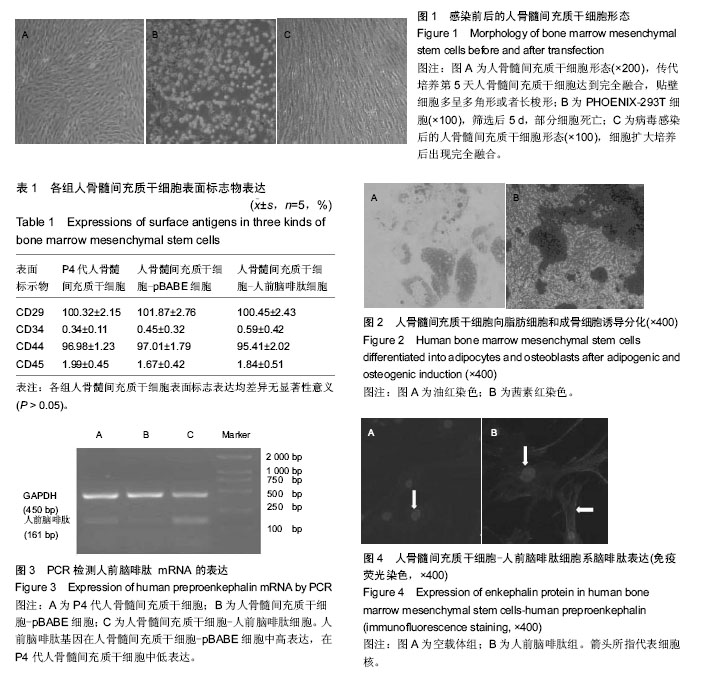| [1] Yang XM, Liu J, Bi HS, et al. Study of analgesia following subarachnoid engraft with microencapsulated human chromaffin cells in rats. Kongjun Yixue Zazhi. 2004;(4):207-210.[2] 任同悦,任铁生.嗜铬细胞移植治疗慢性顽同性疼痛的研究进展[J].中国药物与临床,2004,4(1):57-58.[3] 安珂,田玉科,杨辉,等.鞘内移植人前脑啡肽原丛因修饰的永生化大鼠星形胶质细胞株对大鼠慢性神经痛的镇痛作用[J].中华医学杂志,2005,85(38):2711-2714.[4] 刘惠宁,周望远,杨勇,等.大鼠鞘内注射单纯疱疹病毒Ⅰ型扩增子载体介导人前脑啡肽原基因的表达及对甲醛炎性痛的镇痛效应[J].中南大学学报,2006,31(5):742-746.[5] Eaton MJ, Santiago DI, Danseuse HA, et al. Lumbar transplants of immortalized serotonergic neurons alleviate chronic naturopathic pain. Pain. 1997; 72(1-2):59-69.[6] Wu HH, Wilcox GL, Mcloon SC. Implantation of At T-20 or genetically modified At T-20/h ENK cells in mouse spinal cord induced antinociception and opioid tolerance. J Neurosci. 1994;14(8):4806-4814.[7] 白凤,杨保仲,薛朝霞,等.人前脑啡肽基因修饰人胚胎肾细胞的构建[J]?中华麻醉学,2012,32(6):673-675.[8] 李华艳,杨保仲,聂丽霞,等.应用MADB-106乳腺癌细胞构建大鼠转移性骨癌痛模型[J].肿瘤研究与临床,2011, 23(2):85-87.[9] Cohnheim J. Ueber entzündung und eiterung. Vir Arch. 1867;40(1):1-79.[10] Friedenstein AJ, Gorskaja JF, Kulagina NN. Fibroblast precursors in normal and irradiated mouse hematopoietic organs. Exp Hematol. 1976;4(5): 267-274.[11] Yuehua J, Jahagirdar BN, Reinhardt RL, et al. Pluripotency of mesenchymal stem cells derived from adult marrow. Nature. 2002;418(1):41-49.[12] Mouiseddine M, Francois S, Semont A, et al. Human mesenchymal stem cells home specifically to radiation-injured tissues in a non-obese diabetes/severe combined immunodeficiency mouse model. Br J Radiol. 2007;80 spec No 1:S49-S55.[13] Chapel A, Bertho JM, Bensidhoum M, et al. Mesenchymal stem cells home to injured tissues when co-infused with hematopoietic cells to treat a radiation-induced multi-organ failure syndrome. J Gene Med. 2003;5(12):1028-1038.[14] Shi M, Li J, Liao L, et al.Regulation of CXCR4 expression in human mesenchymal stem cells by cytokine treatment: role in homing efficiency in NOD/SCID mice. Haematologica. 2007;92(7):897-904.[15] Dar A, Kollet O, Lapidot T. Mutual, reciprocal SDF-1/CXCR4 interactions between hematopoietic and bone marrow stromal cells regulate human stem cell migration and development in NOD/SCID chimeric mice. Exp Hematol. 2006;34(8):967-975.[16] De Miguel MP, Fuentes-Julion S, Blazquez-Martinez A, et al. Immunosuppressive properties of mesenchymal stem cells: advances and applications. Curr Mol Med. 2012;12(5):574-591.[17] Si Y, Zhao Y, Hao H, et al. Infusion of mesenchymal stem cells ameliorates hyperglycemia in type 2 diabetic rats: identification of a novel role in improving insulin sensitivity. Diabetes. 2012;61(6):1616-1625.[18] Shen LH, Li Y, Chen J, et al. Intracarotid transplantation of bone marrow stromal cells increases axon-myelin remodeling after stroke. Neuroscience. 2006;137(2):393-399.[19] 杨丽,张荣华,谢厚杰,等.建立大鼠骨髓间充质干细胞稳定分离培养体系与鉴定[J].中国组织工程研究与临床康复,2009,13(6):1064-1068. [20] Polisetti N, Chaitanya VG, Babu PP, et al. Isolation, characterization and differentiation potential of rat bone marrow stromal cells. Neurol Indian. 2010; 58(2): 201-208.[21] 李晓峰,赵劲民,苏伟,等.大鼠骨髓间充质干细胞的培养与鉴定[J].中国组织工程研究与临床康复,2011,15(10): 1721-1725. [22] 范萍,刘永琦,吴晓晶,等.不同条件下骨髓间充质干细胞分离培养及其生物学特性研究[J].细胞与分子免疫学杂志, 2010,(4):322-324. [23] 谢杏榕,李云静,李儒贵,等.胚胎肝细胞提取液体外诱导骨髓干细胞向肝系细胞分化的实验研究[J].现代预防医学, 2013,40(1):124-126. [24] Ramasamy R, Tong CK, Seow HF, et al. The immunosuppressive effects of human bone marrow-derived mesenchymal stem cells target T cell proliferation but not its effector function. Cell Immunol. 2008,251(2):131-136.[25] Wang JW, Liu YB, Xu B, et al. The study on immunomodulation of donor mesenchymal stem cells on discordant liver xenotransplantation. Zhonghua Waike Zazhi. 2005;43(19):1254-1258.[26] 齐丙迪,孟宝玺,杨阳,等.第三方骨髓间充质干细胞诱导同种异体移植受体免疫耐受机制的研究[J].中华整形外科杂志,2011,27(3):207-212. [27] Mei SH, McCarter SD, Deng Y, et al. Prevention of LPS-induced acute lung injury in mice by mesenchymal stem cells overexpressing angiopoietin 1. PLoS Med. 2007;4(9):e269.[28] 续玉林,李刚,吕小东,等.骨髓间充质干细胞移植调节TNF-a和IL-10浓度减轻八稀酸诱导的大鼠急性肺损伤[J].心肺血管病杂志,2012,31(3):324-327. [29] Parekkadan B, Van Poll D, Suganuma K, et al. Mesenchymal stem cell-derived molecules reverse fulminant hepatic failure. PLoS One. 2007;2(9):e941.[30] 周锐,周元平,郑玲,等.骨髓间充质干细胞移植对大鼠爆发性肝功能衰竭治疗作用的初步观察[J].中华传染病杂志, 2012,30(2):85-89. [31] Ito T, Suzuki A, Imai E, et al. Bone marrow is a reservoir of repopulating mesangial cells during glomerular remodeling. J A Soc Nephrol. 2001; 12(12) 2625-2635.[32] Kale S, Karihaloo A, Clark PR, et al. Bone marrow stem cells contribute to repaire of the ischemically injured renal tubule. J Clin Invest. 2003;112(1):42-49.[33] 董晨,杨焕丹,丰炳峰,等.骨髓间充质干细胞对阿霉素肾病大鼠肾脏nephrin表达的影响[J].中国组织工程研究与临床康复,2010,14(32):5897-5902. [34] Wu QI, Li YI, Feng ZT, et al. Bone marrow stromal cells of transgenic mice can improve the cognitive ability of anAlzheimers disease rat model. Neurosci Lett. 2007; 417(3):281-285.[35] 邬伟,杨景全,陈松芳,等.骨髓间充质干细胞移植对阿尔茨海默病大鼠学习记忆能力的影响[J].温州医学院学报, 2008, 38(5):412.[36] Li LY, Li JT, Wu QY, et al. Transplantation of NGF-gene-modified bone marrow stromal cells into a rat model of Alzheimer disease. J Mol Neurosci. 2008; 34(2):157-163.[37] 陈丹丹,付文玉,庄宝祥,等.骨髓间充质干细胞黑质内移植对帕金森病大鼠的治疗作用[J].中国实验动物学报, 2013, (1):22-26. [38] 赵学俊.自体骨髓间充质干细胞移植在中枢神经系统疾病中的应用[J].中国实用神经疾病杂志,2012,15(8): 69-70. |
.jpg)

.jpg)